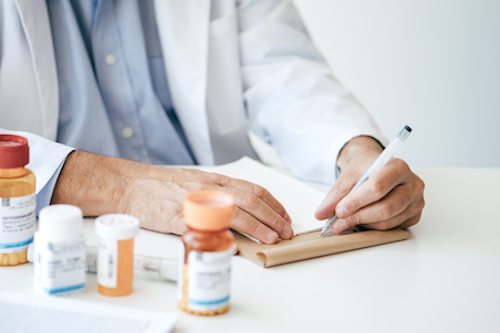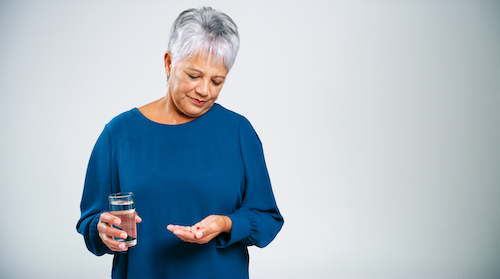Reviewed by Dr. Sarika Arora, MD
In many ways, we live in the best of times. For those of us in advanced countries, women have rights and a standard of living that our ancestors could hardly have imagined. Let’s be mindful of that and grateful to live in the here and now.
We also have to face the fact that this is a challenging time for women’s health. Life expectancy is high, but rates of most diseases have increased, especially for women — and it’s not just because we’re living longer.

Fifty years ago, a girl had a 1 in 15 chance of developing breast cancer in her lifetime. Today those odds are 1 in 8 – quite alarming! There has also been a significant increase in the whole spectrum of hormonal disorders, including diabetes, thyroid disease, and Alzheimer’s. Rates of autoimmune and degenerative disease have also skyrocketed. In most of these cases, women are affected more than men.
Today these illnesses appear in increasingly younger patients, and in more severe forms. Patients also present more frequently with “mystery diseases.” Their suffering is real, but their doctors question whether the disease is real– or just in their minds.
Table of contents
- Chronic disease, conventional medicine, and women’s health
- A system that frustrates women and doctors alike
- Big Pharma and women’s health
- Big Pharma isn’t the only business that’s damaging women’s health
- Alternative medicine and women’s health
- 10 scandals of women’s health
There are also widespread problems with the expense of health care, and women’s lack of access to it. But the real question is – why are women so sick, and why aren’t they getting better?

Chronic disease, conventional medicine, and women’s health
Common sense tells us that before we can prevent or treat a disease, we must understand the root cause. But there is not enough discussion about why chronic and degenerative diseases are increasing so rapidly, or why women are most likely to be affected.
The problem with labeling illness as “chronic” is that the focus is on managing them, not curing them. Prescription drugs, with serious side effects, are given to mask symptoms, but patients receive the message to prepare for a gradual downturn in their health. Patients have so much faith in their doctors that if they’re told they’ll only get worse, they often will and do! Unfortunately, women are almost never informed of alternatives to conventional treatments. (We’ll come back to that in a moment.)
A system that frustrates women and doctors alike
You probably have a mother, sister, or close friend who has struggled for years with a chronic illness or chronic symptoms – and they usually have a sad story to tell of a trail of doctors, battles with hospitals and insurance companies over billing and reimbursement, side effects that often seem as troublesome as the initial illness…they’ve been given more pills to deal with those side effects…the side effects increase over time while the effectiveness of the drugs declines… and always, remorselessly, a steady worsening of their condition. This may be your own story.

It’s beyond frustrating. What we spend on healthcare – and health insurance, if we have it – is at an historic high…so high that many can’t afford it. In the USA we spend 50% more per person on health care than any other country in the world. What this health care is supposed to deliver — better health — just isn’t happening for many women.
If you think we’re bashing conventional doctors, we are not. The system is a trap for doctors too. While record numbers of women have become doctors, an increasing number of doctors want to leave their profession. More doctors now work for medical companies than ever before, and they are pressured to treat patients in less and less time. What can you do with a patient in six minutes except prescribe her a drug?
Big Pharma and women’s health
It’s no coincidence that drug company profits have reached historic highs. We take more drugs to treat medical problems in the U.S. than in any other major country — about 46% of the population takes at least one prescription medication. The average 50 year old woman takes four prescription drugs – usually on a semi-permanent basis; many elderly patients take a dozen or more. And we pay more for these drugs too, compared to other countries. Average annual spending on prescription drugs is over $1,000 per person and 16.7 percent of overall personal health care spending.
Doctors prescribe drugs even when natural treatments such as healthy eating and exercise are clinically proven to be at least as effective, in part because doctors don’t think patients are interested in making lifestyle changes. But it’s also because in our system of conventional-medicine-reimbursed-by-insurance, the doctor can’t counsel a patient in a six-minute appointment on such complicated matters – he can’t bill for it, either, which gives him an incentive not to mention it at all.

At the same time, it’s important to know that most doctors are not educated about the research on natural treatments, and weren’t trained in nutrition or complementary medicine in medical school. A patient might easily conclude that if her doctor isn’t talking about natural approaches, it’s because they don’t work. But this is simply not the case. The majority of physicians know very little about these subjects. You may know more.
Every woman needs to know that “Big Pharma” is over a trillion dollar industry – about 25% as big as the whole Federal budget in the United States. Its profits exceed that of any other industry, and while Big Pharma eagerly publicizes how much it reinvests in research and development (R&D), this is disingenuous. The truth is that the industry’s profits exceed its R&D spending, and its marketing budget is almost as big as its R&D.
About half of all drug revenues in the world come from North America alone, so its influence here is unprecedented. Big Pharma has been accused by credible sources of controlling major medical schools, leading medical journals, the American Medical Association, the organizations that govern the standard of care in most medical disciplines, mainstream media (it’s also the biggest advertiser of any category), FDA regulation and processes, and Congressional policy.

All this influence affects your medical care. Information available to doctors can be misleading, or even downright dangerous to patients. Over half of drug company revenues are “off-label”, meaning that the drug is being used for a purpose other than the one for which it was approved by the FDA. The FDA’s new fast-track drug approval process also leaves women open to side effects that are not caught in the shortened testing process. Why should a woman take a drug for years that has only been tested for six weeks?
At the same time, the prescription drug industry funds a never-ending campaign to discredit alternative medicine as unproven, despite thousands of credible studies supporting alternative methods. The constant refrain of this campaign is that nutritional supplements are “unregulated”, which is completely untrue. The industry is against alternative approaches until the public starts demanding them because they’ve been seen to work. At that point, they co-opt these approaches, advertise “new breakthroughs” as if they’re the source, and broaden their monopoly over health care.

Big Pharma is about profits, not health. What does this mean for you and yours? One thing we can say with confidence is that the industry has perfected two mechanisms that favor its long-term interests over yours. First, it has entrenched the linkage of symptom-test-prescription that dominates medical practice for everyday health problems. If you have a symptom, your doctor gives you a test; if you have a certain test result, you get a particular drug prescription. That’s the kind of medicine that fits into a 6-minute doctor’s appointment.
Second, consumers typically only hear part of the picture from doctors. Why? Because health claims can only legally be made for FDA-approved drugs—and FDA approval only happens because a drug company had the money to conduct a very expensive study. As a senior FDA official once said, even if vegetable juice had been proven to cure cancer, a seller of vegetable juice couldn’t say so – unless he had spent $1 billion to get it registered as an approved drug. Why would anyone do that unless they could patent it?
What this means is that health claims can’t be made about natural methods, even if there is very good science to support their efficacy in improving your health, by themselves or in conjunction with conventional medicine.
This system creates a virtual monopoly for drugs in the treatment of disease – or at minimum, the treatment of symptoms.
Big Pharma isn’t the only business that’s damaging women’s health
There are other giant industries that influence public policy on women’s health – and your health is not their top priority, either. Let’s just look at a few examples.
The sugar industry and its brother, the processed food industry, have been conspiring for decades to conceal the negative effects of their actions on our health. In a 1960’s scandal that has come to light only recently, the sugar industry paid researchers at Harvard to counter studies that showed sugar was the real cause of the increase in heart disease. They conspired to blame high fat intake instead, manipulating data to make their case.

Their success led to decades of policy to lower our fat consumption (think of all the low-fat products you’ve bought!) and take statins to reduce our cholesterol levels. In fact, sugar intake is a much bigger factor in heart disease than serum lipid levels. Low-fat foods increase the manufacturers’ profits but not the nutritional value of your diet. Sugar consumption has continued to rise, as have the incidence of heart disease, diabetes, pre-diabetes and metabolic syndrome. There are estimates that Type 2 diabetes now costs the USA over 3% of GNP – roughly equal to the entire Federal budget deficit.
The low-fat craze is especially damaging for women because the building block of all sex hormones– including the estrogen and progesterone you need for hormonal balance – is…wait for it…cholesterol! That’s right: you need to consume fat to balance your hormones. You can’t do that by eating low-fat engineered foods that crowd the aisles of most grocery stores, decades after the sugar industry conspired to mislead us all. They are still succeeding!
The fast food industry is also involved. What you should know is that a recent study showed that the sugar and calorie content of the average fast food menu has continued to climb, despite their claims about their new healthy options.
One more example: the chemical industry. From 1940 until now, western economies have been transformed by the number of chemicals used in everyday life. From a handful of chemicals in the world of our great-grandparents, we are now exposed on a daily basis to thousands of chemicals. You probably assume our government has tested those chemicals for safety. The truth will disappoint you. Under intense lobbying, governments have tested less than a dozen out of over 20,000.

The effect of these toxins has been an increase in cancer, birth defects, autoimmune disease, lower fertility rates, and much more. The science on these connections is clear. Of special concern are the xenoestrogens in pesticides and plastics, chemicals that have estrogenic effects in the body. Toxins don’t just contribute to cancer; they also cause inflammation and impaired immune function. We now detect these toxins in breast milk, drinking water, farm-raised beef, pork and chicken, the umbilical cords of babies, even wild fish caught in the ocean!
Not only has the industry largely avoided regulation, it has also fought hard in courts to avoid legal liability for the health consequences. Until the recent victories in jury trials against Monsanto, the industry had created a legal doctrine that it could not be held responsible for cancer unless its chemical was proven to be the one and only cause of the victim’s cancer. Since cancer is multifactorial, that was essentially an impenetrable shield. For decades, only asbestos claimants had ever succeeded, because the form of cancer asbestos caused was otherwise never seen in nature. Damages were also eventually awarded against Big Tobacco. Everyone else escaped blame or penalty for the endless number of people they’ve harmed.
It’s time for some good news about women’s health!

Alternative medicine and women’s health
What we call “alternative medicine” today was called “holistic” 50 years ago. “Holistic medicine” looked at “the whole” – that is, how the systems of the body work together, and how the body’s health is connected to our environment, our histories and our everyday experiences and lifestyles.
This philosophy is the basis of all traditional forms of medicine, from the folk medicine of primitive peoples to the ancient systems of Ayurvedic medicine and Traditional Chinese Medicine (TCM). Holistic medicine has resonated with women for thousands of years because it addresses how the body naturally functions.
Alternative medicine today is far more advanced, more scientific, and better accepted than ever before. Over half of all doctors claim to offer alternative and complementary methods, and half of all medical schools claim to teach these methods, though this is still more lip service than real. The NIH regularly spends millions in support of clinical trials of alternative therapies. They are only following consumer demand. Visits to alternative practitioners exceeded those to conventional doctors over 20 years ago, and the margin has only widened since.

It’s important to note that alternative medicine has its challenges as well. For many people, it’s an ideology whereby everything “natural” is automatically considered better. This makes its followers vulnerable to the excessive claims of gurus and shoddy science. Just because an approach is labeled “natural” or “alternative” doesn’t mean it’s reliable or the best option.
Worst of all for women, the two camps are enemies. Conventional medicine ridicules alternative medicine, while Big Pharma funds trials and studies and publicity campaigns to discredit it — unless they figure out a way to profit from it. On the other side, many alternative practitioners speak of orthodox doctors as though they were evil. There is a small contingent of “integrative practitioners” that embrace a mix of conventional and alternative therapies. But they are not changing many minds – at least, not yet – which is tragic, because you would be so much better served if alternative and conventional medicine worked with each other.
Are you seeing how the pieces fit together to form a system that doesn’t serve you well? Actually, even if you’re already convinced, we need to dig even deeper. If we look at every major health condition afflicting primarily women, we’ll find a medical scandal. Let’s do that, at least in brief. Then we can talk about what has to change in women’s health – and what you have to do to help yourself and those you love. Because it’s up to us.

10 scandals of women’s health
We could do 20 examples – or even 50 – but 10 should be enough to illustrate the pattern of problems behind the major conditions in women’s health. (We offer articles on most of these problems elsewhere on our website, and the links shown below will take you to them.)
#1: Underactive thyroid – Tens of millions of women suffer from low thyroid function; the medical term is subclinical hypothyroidism. Because the thyroid is so entwined in the body’s metabolism, an underactive thyroid is almost never the only problem. Alternative medicine would analyze the entire endocrine system, but the tests and remedies used in conventional medicine don’t do that. Instead, the standard tests show a wide range of “normal” results, and offer a therapy only when extremes are reached, which are considered disease states. As a result, most women receive no help from their doctors until their condition is so advanced it’s irreversible. But the holistic approach to diagnosis and therapy has been shown over and over in clinical practice to prevent the disease state from developing.

#2: Depression and anxiety – Women are prescribed antidepressants three times more often than men. Are they really so much more likely to be depressed, or is the doctor simply at a loss for better ways to treat mood disorders caused by hormonal imbalance?
Apart from true depression – an acute condition with psychological causes – ordinary depression and anxiety are often symptoms of organic problems. To alternative practitioners, it makes no sense to give a drug to conserve serotonin (the mechanism of action is in the name SSRI – “selective serotonin reuptake inhibitors”) – when the real question is, why isn’t the body making enough serotonin? Often they find the underlying cause is imbalanced intestinal flora. Over 90% of our serotonin is made by intestinal bacteria which, when balanced, have a host of other health functions as well. Holistic doctors rebalance the intestinal flora and take other steps to reset the endocrine system. We also put too much faith in the cure-all qualities of SSRI’s. For 30% of women, they offer no benefit, and for many others, the benefits decline over time. The side effects are numerous and often severe.
#3: BCP’s for everything – “The Pill” has earned a near-magical reputation by freeing women from the fear of an unwanted pregnancy. But over time it has come to be seen by doctors and patients as a “magic pill” that cures many ills without risks or side effects. This aura has developed despite the numerous adverse side effects of hormonal birth control, from greater risk of depression, stroke, colitis, autoimmune disease, osteoporosis and breast cancer, many of which are never described to the patient. In practice, doctors often prescribe BCP’s for conditions such as irregular periods and hormonal acne, when the underlying cause of those relatively benign problems is hormonal imbalance, not fertility. The only health problem that The Pill is meant to solve is an unwanted pregnancy – for which there are many alternatives that should also be considered.

#4: Drugs for digestive disorders – More than one million women have taken WHN’s health surveys over the years, and more than 60% of them report digestive problems – bloating, gas, diarrhea and/or constipation. In otherwise healthy patients, these problems are nearly always conclusive signs of intestinal dysbiosis, the medical term for imbalanced gut flora. Imbalance between “good” and “bad” intestinal bacteria is also probably the underlying cause of many other serious gut problems, including Irritable Bowel Syndrome, Diverticulitis, Crohn’s Disease and “leaky gut syndrome”; it’s also been implicated in dozens of other conditions, from autism to Alzheimer’s.
A healthy balance of gut flora can be remedied by a combination of dietary changes, prebiotics, probiotics, and in extreme cases, fecal transplants. This natural approach is proven to be more effective than drugs, and without side effects. Alternative physicians offer all these remedies unlike conventional medicine, which prescribes drugs that may ameliorate the symptoms, but offer no cure. Because conventional doctors may not know of the benefits of alternative therapies, they rarely recommend them to patients.
#5: Weight loss & dietary science – For decades, women were taught that “a calorie is a calorie”, and that weight loss was a matter of calorie restriction, exercise and will power. In other words, if you were fat, you were to blame. This was the conventional wisdom for the whole period in which obesity and diabetes reached epidemic proportions. Alternative doctors preached another theory that academics have only recently come to validate. Today the science proves that the calorie-restriction theory is totally false, even harmful to women. But most conventional doctors have stuck with the old ideas.
The up-to-date experts know that weight gain is also a function of stress, hormonal imbalance, toxins and other factors. We’ve learned that all calories are not equal – those that contribute to hormonal or floral imbalance are much more negative. We’ve realized that registered dieticians advocate a food plan that actually leads to weight gain, and that business lobbying has created a misleading government “food pyramid”.

It’s been revealed that not all fruit is equal, either, and it certainly shouldn’t be equated with vegetables, as it is officially. After years of praise, it’s been proven that BMI is not a good measure of healthy weight, since it penalizes women for being strong and athletic. After a succession of hundreds of failed diets – the average 40-year-old American woman has tried over 12 diets – we’ve come to know that there are several diets that actually work. What’s most important is focusing on healthy weight, not losing weight. WHN teaches you several ways to get there.
#6: Osteopenia and bone health– For more than a century, a doctor diagnosed osteoporosis only when you suffered a broken bone for no good reason. This rarely happened to women who ate well and remained physically active. But as women did less hard work, rates of osteoporosis grew. Why didn’t we see the connection and urge women to get more weight-bearing exercise?
At least part of the explanation is that there’s no money in prescribing exercise. The drug companies drove the standard of care toward their self-interest. For years they advised doctors to prescribe a variety of medical treatments instead of exercise – estrogen, calcitonin (another hormone), and nutritional supplements. But the breakthrough event was the development in 1987 of DEXA, a new machine which measured bone density. Once bone density could be measured, drug companies argued that a lack of bone density caused osteoporosis, and began developing drugs to build it. There was no evidence that low bone density raised the odds of fracture, but this was ignored.

Big Pharma knew that bisphosphonates built bone density, and they raced one another to develop a drug with a risk/reward ratio that would win certification from the FDA. Instead of advising women to go to a gym and lift weights, they made it seem much more scientific to say that at a certain level of bone density, a woman needed medicine to prevent her breaking a bone in the future.
That level was conveniently measured as a percentage of a 30-year-old white woman’s bone density, which made for a huge market. After all, what older woman wouldn’t have a lot less bone than a 30-year-old? While bisphosphonates took years to develop, the company that made the estrogen used in treating osteoporosis realized it would make a lot more money by enlarging the patient pool. In 1992 it convened an international conference, and its paid experts told the attendees they should recognize a new diagnosis, osteopenia, as an intermediate step on the way to osteoporosis.
On that basis, they warned America that 30 million women were suddenly at risk of osteoporosis, which was a terrifying number. It didn’t matter that this wasn’t true, or that nearly none of those women would actually ever break a bone. Shortly after this (in the mid-1990s) bisphosphonates were finally approved by the FDA, and its maker fed off the hysteria about osteopenia and osteoporosis. The side effects of the new drug, some of which were horrible (e.g. necrosis of the jaw), were little mentioned. The fact that there were natural methods to build stronger bones that were more effective than the drugs — and had only “good” side effects — was never discussed and rarely studied.

Today most women think all they need do to maintain healthy bones is to take “cal/mag” supplements, have their annual bone density test, and take the medicines the doctor prescribes. The risks they are under from poor diet, lack of exercise, stress and worry are not discussed – i.e. those are the primary causes of poor bone health, and if you fix those, you don’t need the drugs, but if you take the drugs without fixing them, the drugs don’t improve your odds. They don’t understand much about bone health at all until they’re given the DEXA test at some point and their doctor tells them they should start taking bisphosphonates.
The real problem is that more and more women do have poor bone health, and one fact hasn’t changed: of the women over 65 who fall and break a hip, 50% will die within a year. It isn’t that breaking the hip kills them, but the long downward slide in their overall health that led to the fateful fall. The approach of conventional medicine has made billions for Big Pharma but hasn’t “moved the dial” in women’s bone health. Women need a better approach, but doctors and the drug industry are happy with the status quo.
#7: High blood pressure/hypertension – Here is a real medical epidemic with life-threatening consequences for which conventional medicine has effective drugs. These drugs keep many women alive and functional who wouldn’t be without them. The issue from our perspective is that too few women are told they should supplement their medicinal approach with natural methods to lower their blood pressure. These include dietary changes, nutritional supplements, lifestyle changes, stress reduction, and of course exercise. Because the prescription drugs have such serious side effects, tend to diminish in efficacy over time, and are generally taken for the rest of the patient’s life, having natural adjunct therapy is vital. It allows for lower dosages, longer time periods of sustained efficacy, and better long-term outcomes.
But for all our talk in the healthcare system of the importance of prevention, we really haven’t integrated such alternative methods into conventional care. Doctors often have despaired that their patients would be willing to make such changes, but given these facts they have a responsibility to try. There are also millions of patients who are “pre-hypertensive” who would benefit especially from lifestyle interventions.

#8: Hormonal imbalance and menopause– Hormonal imbalance may be the most prevalent problem in women’s health. In truth, all illnesses arising from hormonal imbalance show epidemic increases. Hormonal imbalance itself is inflammatory, disturbs the cross-signaling of immune function and detoxification, and accelerates cellular aging. But when a woman comes to a conventional doctor complaining of menopause symptoms, his response is to overpower the complexity of her endocrine system with a daily dose of synthetic hormones – HRT.
For over 60 years, Premarin (a synthetic estrogen with progestin derived from pregnant mares urine) was touted as a cure-all for wrinkles, depression, bone loss and dozens of other problems, not just menopause. Its maker claimed its safety was supported by scores of clinical studies. Only through the objective Women’s Health Initiative (WHI) study did we learn the truth: synthetic HRT caused significant increases in breast cancer, stroke and heart disease. Big Pharma fought back for 15 years, arguing the WHI study was flawed, and that even with its risks, HRT was a good alternative. But the Lancet just published a meta-study confirming the risks of synthetic HRT are as bad or worse than the WHI first showed.
#9: The controversy over adrenal health– Alternative practitioners have been saying for over a decade that there is a disorder of adrenal function that requires holistic diagnosis and treatment. They describe it as a gradual loss of function in response to constant stress, mediated through excess levels of cortisol. Conventional practitioners pooh-pooh this idea. But why? They claim that there are only two diseases of the adrenal glands – Addison’s and Cushing’s – and that every other stage of adrenal function is normal. But this is the same logical fallacy behind the tens of millions of undiagnosed cases of subclinical hypothyroidism.

It’s common sense that the gradual failure of an endocrine organ can be identified and measured, and that the practitioner should seek to treat it before the disorder becomes a disease. But because the conventional practitioner lacks the tools and knowledge to diagnose the problem, or prescription drugs to treat it, he defensively argues that the disorder – and the opportunity to help the patient at an early stage – does not exist. Meanwhile, the women stuck with those conventional caregivers suffer unnecessarily. The absurdity of this denial is obvious when you consider that in other settings, conventional doctors recognize that the adrenal glands are holistically related to all other endocrine functions, such as when dealing with a patient on long-term cortisone treatment. Why does adrenal function need to be nurtured and restored in one setting – excess cortisone – but not in the other – excess cortisol? Too many women seeking relief have to find it on their own.
#10: Chronic Lyme – Lyme disease has been described as an epidemic for many years now. It’s reported as the spread of a pathogen, Borreali burgdorferi, perhaps exacerbated by climate change, which causes warmer winters and a larger range for the deer ticks that transmit the infection. The press coverage describes growing numbers of people infected, the spreading map of reported cases, and how to use insect repellant and clothing to fend off the bugs. Conventional medicine responds with its tests and huge doses of antibiotics. But the alternative community has a completely different point of view – one that better fits the facts.

In this view, the epidemic of Lyme is caused by the collapse of immune function in large segments of the population. The belief is that the conventional test for Lyme indicates only prior exposure, not current infection, and that while antibiotics are first-line therapy in the earliest cases, in advanced Lyme antibiotics alone do further harm to the immune system without eliminating the infection. A deeper level of testing and therapy is proposed, both to identify active infection and to rejuvenate the power of the immune system. They differentiate among the “mystery conditions”, such as fibromyalgia, that conventional medicine often lumps into “advanced Lyme”, in part because conventional doctors feel helpless to treat one but not the other. That’s probably a big reason why women are many times more likely than men to be diagnosed with advanced Lyme – or is it that women are more likely to have suppressed immune function? Once again, we see that in a common health condition, conventional medicine does not serve women well.
Peculiar views on women’s health
When most women think of being healthy – in the absence of a diagnosed illness – their usual concerns are being attractive, thin and youthful looking. These are not really health concerns – they are concerns about how others view us.
The problem with these concerns is the same as choosing high heels despite their affect on your feet. Letting others define our health priorities in terms of how we look takes our power away, sometimes to the point of helplessness. Don’t be a fashion victim. This focus on appearances displaces what should be our real priorities. It makes us believe in purple pills – magical substances that give us the things we want. Lots of people are making money off women who wish for purple pills.
Instead, we should be asking are we hormonally balanced? Is our diet and digestion healthy? Do we have strong muscles and bones and cardiovascular conditioning? Do we have systemic inflammation? When we have the right answers to those questions, good health is almost inevitable. We’ll have a healthy glow and lots of energy and endurance. We’ll look younger than our years. We’ll resist disease and age gracefully.
How do we fix women’s health?
Women can’t fix what’s wrong with women’s health all by themselves. But women do make most health care decisions for themselves and their families. Today, more than a third of all doctors are women – and since more than half of new doctors are women, that percentage will go up every year. Women are more in touch with the biology of their bodies and minds, which is a big reason why women are much more inclined than men to support holistic and alternative health. Women more easily see the merits of both sides of an argument, which is how we’ll solve the impasse between conventional and alternative health. And frankly, women are more rational and open-minded, which makes them very good at being agents of change.

So, women can’t fix things all by themselves – but women will be the leaders and the catalysts. We think they just need the information that’s now missing to be able to do that. We try to provide that on a personal level, that is, for women about their own health. Others are working on the national policy questions – we recommend you National Women's Health Network.
Our mission is to give women that missing information everywhere we work – on our website, in our publications, in our videos on YouTube, and in social media. If there’s something missing you’d like us to cover, write to us at support@womenshealthnetwork.com. Or join us on Facebook and post your ideas. We’ll make it happen!
References
https://www.breastcancer.org/symptoms/understand_bc/statistics
https://www.ncbi.nlm.nih.gov/pmc/articles/PMC4176857/
https://www.jwatch.org/na34807/2014/06/24/thyroid-disease-women-midlife
https://www.ncbi.nlm.nih.gov/pmc/articles/PMC5058901/
https://www.ncbi.nlm.nih.gov/pmc/articles/PMC6390276/
https://www.medicalnewstoday.com/articles/246960#1
https://www.aamc.org/news-insights/press-releases/women-were-majority-us-medical-school-applicants-2018
https://www.nbcnews.com/business/business-news/doctor-out-why-physicians-are-leaving-their-practices-pursue-other-n900921
https://health.usnews.com/health-care/patient-advice/articles/2018-01-10/heres-why-your-doctor-seems-pressured
https://www.bloomberg.com/news/articles/2019-05-08/nearly-one-in-two-americans-takes-prescription-drugs-survey
https://assets.aarp.org/rgcenter/health/rx_midlife_plus.pdf
https://www.nytimes.com/2018/11/12/upshot/why-prescription-drug-spending-higher-in-the-us.html
https://www.statista.com/topics/1764/global-pharmaceutical-industry/ (trillion dollar Big Pharma) and https://www.nationalpriorities.org/budget-basics/federal-budget-101/spending/ (3.8 trillion federal budget)
https://www.statista.com/topics/1719/pharmaceutical-industry/
https://www.physiciansweekly.com/doctors-losing-publics-trust/
https://www.americanprogress.org/issues/democracy/reports/2019/08/30/473911/big-pharma-reaps-profits-hurting-everyday-americans/
https://www.nytimes.com/2016/09/13/well/eat/how-the-sugar-industry-shifted-blame-to-fat.html
https://www.ncbi.nlm.nih.gov/pmc/articles/PMC5133084/
https://www.who.int/news-room/fact-sheets/detail/dioxins-and-their-effects-on-human-health.
https://www.ncbi.nlm.nih.gov/pmc/articles/PMC4682569/
https://www.theatlantic.com/magazine/archive/2011/07/the-triumph-of-new-age-medicine/8554/
https://www.ncbi.nlm.nih.gov/pmc/articles/PMC1117269/
https://www.ncbi.nlm.nih.gov/books/NBK83794/
https://www.womenshealthnetwork.com/thyroid-health/subclinical-hypothyroidism-symptoms.aspx
https://www.youtube.com/watch?v=ikPipvkD8Tc
https://www.ncbi.nlm.nih.gov/pmc/articles/PMC5451647/
https://www.sciencedaily.com/releases/2019/09/190906092809.htm
https://www.womenshealthnetwork.com/osteoporosisandbonehealth/the-diagnosis-of-osteopenia.aspx







